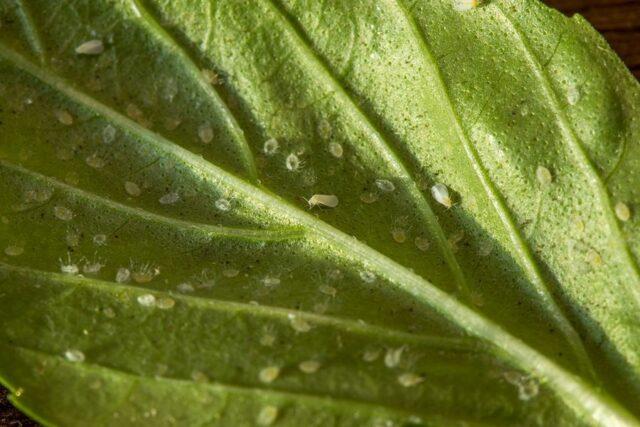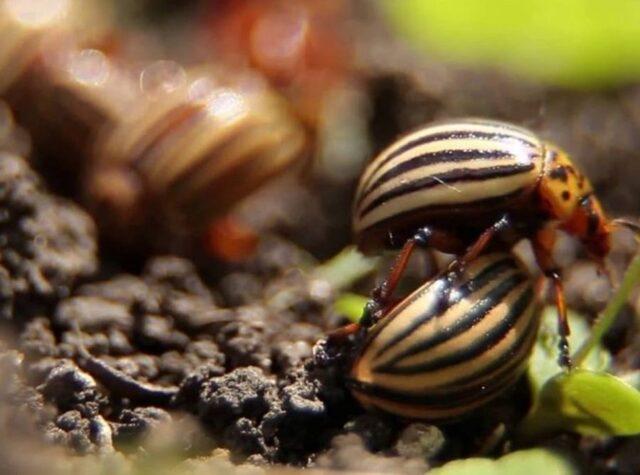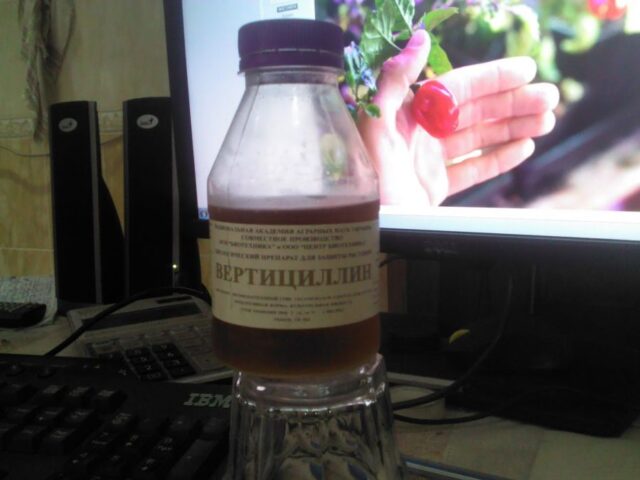Content
Pepper pests in a greenhouse can cause severe damage to plantings and make them vulnerable to fungi and viruses. To get rid of insects, you must first of all recognize their presence in time.
Causes of pests on peppers
Insects can attack peppers under any growing conditions. But some factors increase the likelihood of pests appearing on vegetable crops. In particular, peppers often suffer from parasites:
- in an unfavorable climate - excessive heat in the greenhouse and lack of ventilation contribute to the appearance and active reproduction of pests;
- if agricultural technology is not followed, insects multiply intensively on waterlogged soil in the absence of loosening and an abundance of weeds;
- in dense conditions - pepper bushes growing too close to each other do not receive enough light and oxygen, pests multiply more often on their leaves;
- on contaminated soil - insect larvae may be present in untreated soil, in which case the vegetable crop finds itself in unfavorable conditions already at the time of planting.
The presence of pests can be suspected by damage to the leaves and wilting of the stem. Bushes affected by insects often suffer from bacterial diseases, late blight and rot.
Pests of bell pepper
Bell peppers in a greenhouse suffer from many pests. Some of them affect leaves and are relatively easy to eliminate. Others attack the roots of the plant, and in this case their presence can only be recognized when the bushes begin to die.
Aphid
Green or brown aphids attack bell peppers on contaminated soil, when there are ants in the area, or when using dirty garden tools. You can recognize the presence of a pest by deformation of the leaves and the formation of a sticky, shiny film on the plates. Upon closer inspection, you can see a large number of small insects on the pepper - they can literally stick around the plant.
Aphids feed on leaf sap and can quickly destroy crops. At the same time, getting rid of the insect is quite easy - in the early stages, spraying with a homemade soap solution is enough.

An additional danger of aphids is that the insect carries viral diseases
Whitefly
A small whitefly butterfly lays eggs on pepper leaves. Hatching larvae suck the juice from the plant and secrete a sticky secretion, which further contributes to the development of fungal diseases.You can suspect the presence of whiteflies first of all by drying and curling of the leaves.
Pest control is usually carried out using garlic or soap solution. If there are a lot of insects, you can use Confidor and Fufanon.

Whitefly larvae usually breed on the underside of pepper leaves.
Wireworm
A dangerous pest of pepper roots is wireworm. Brown-orange caterpillars up to 4 mm in length damage the underground parts of the plant, disrupt feeding processes and cause bushes to wilt. One generation of insects can parasitize pepper for up to four years.
It is necessary to combat wireworms by autumn digging and treating the soil with ash or lime. Chemical preparations include Bazudin and Provotox, but it is not advisable to use insecticides during the ripening period.

As part of the fight against wireworms, you can plant mustard near the pepper - the pest does not like its smell
Colorado beetle
The pest with an oval body and striped wings overwinters at the roots of peppers, and in the spring it comes to the surface of the ground and feeds on the leaves of the crop. Causes serious damage to plantings and can destroy them almost completely; it poses a danger both at the larval stage and in adulthood.
Since the Colorado potato beetle is easy to spot on pepper leaves, it can be controlled mechanically. If there are few insects, they are simply collected by hand and destroyed. In case of serious damage to plantings, it is better to use insecticidal preparations Aktara, Kaiser and similar ones.

The Colorado potato beetle overwinters in the soil at a depth of up to 50 cm, which makes it difficult to get rid of it when digging up the soil.
Ants
Ants do not directly harm bell peppers, but they almost always cause aphids to appear on the site, so they also need to be controlled. It is recommended to place sweet baits with poisonous borax in those places where insects run most often. Anthills on the site must be destroyed; if necessary, you can use the strong drugs Grom-2 and Muratsid.

Garlic, parsley or wormwood planted nearby help repel ants from peppers.
Caterpillars
Serious damage to bell peppers in greenhouses and soil is caused by all kinds of caterpillars, among which the following appear especially often:
- gamma scoop;
- winter;
- cotton;
- caradrine;
- garden;
- exclamation point
The caterpillars differ among themselves in color - they can be green, brown, yellowish-brown, single-colored or striped. But the pests cause the same damage - they eat pepper leaves, interfere with flowering and worsen the crop’s yield.

Caterpillars appear on peppers mainly in April-May and July-September
The presence of caterpillars is indicated primarily by holes in the plates, their curling and yellowing. The fight against insects of any kind is carried out with the insecticides Decis, Intavir and Aktara; for mild infestations, Fitoverm and Agravertin help.
Naked slugs
At high humidity, pepper plantings can be harmed by slugs - mollusks without shells. Most often, gastropods attack young, soft and juicy seedlings.
Pests of pepper leaves move mainly at night, but during the day you can notice their presence by large holes on the plates and characteristic sticky marks.Under the influence of parasites, bushes turn pale and quickly wither. You can fight gastropods with the drugs Slug Eater and Ferramol; mustard in the form of an infusion or dry powder helps a lot.

To eliminate slugs, pepper beds are recommended to be regularly sprinkled with wood ash.
Shchitovka
The pest, with a round body and a hard brown shell, reaches no more than 2 mm in diameter, and is quite difficult to see on peppers. The presence of the insect is indicated by damage to the leaves - the plates lose moisture and dry out, dark plaques and a sticky coating appear on their surface.
Since the scale insect is very small and tightly attached to the pepper, manual collection of the pest is usually not carried out. To eliminate the insect, use Aktara and Actellik, garlic or onion infusions.

Scale insects can be prevented by regularly spraying pepper on the leaf.
Spider mite
In dry and hot weather, pepper bushes can be attacked by spider mites - a small pest with a greenish or brownish-brown body. It is difficult to see the insect, but yellowish dots on the leaves of the crop and spider threads between the stems help to recognize it. The mites themselves settle on the underside of the pepper plates and feed on its juice. As a result, the bushes turn yellow, wither and die.

If the spider mite infestation is minor, you can spray the pepper with tobacco infusion
The chemicals Karbofos and Intavir help well against the pest. If the bushes are damaged too much, they need to be removed from the site.
Scoop
Gray-brown cutworm butterflies lay eggs on pepper leaves, and in early summer they hatch into numerous greenish caterpillars. The pest feeds on plates and ovaries and damages ripening fruits. The armyworm may produce colonies of larvae twice during the summer, causing severe damage to pepper plants.

The armyworm often spreads to pepper from nettles
If there are few caterpillars on the leaves, they can be collected by hand and washed off using sprinkling. In case of a massive attack of pests, it is recommended to use chemicals - Decis, Zolon, Volaton and Arrivo.
Thrips
A small pest on pepper leaves feeds on the sap of the plant and is also a carrier of many dangerous infections. Thrips can be recognized by their characteristic behavior - they fly very quickly from bush to bush, and from the direction of their movement they appear to be bouncing.

Decoctions of garlic and onion peels are good against thrips.
To eliminate the pest, it is recommended to place sticky traps near the pepper. If there are a lot of insects, you should use Karbofos, Actellik and Vermitek.
Medvedka
A dangerous garden pest moves underground, digs long tunnels and damages the roots of pepper bushes. As a result, plants dry out and die, even if their green parts remain intact.
It is quite difficult to get rid of the mole cricket, since it practically does not appear on the surface. Usually, soap solution and Bankol, Medvetox and similar preparations are poured into the passages left by the pest. Setting up manure traps at a depth of 30 cm in the ground helps a lot - mole crickets crawl to the smell, and it becomes easier to destroy them.

To prevent mole crickets, the soil in the greenhouse and on the site needs to be dug up in spring and autumn.
Khrushchev larva
The Khrushchev larva has a white body twisted into a ring with three pairs of dark legs. It lives at a depth of about 20 cm, feeds on the roots of peppers and especially damages young seedlings.

Khrushchev larvae can live up to four years
You can learn about the presence of a pest by slowing down the growth of bushes, wilting of green mass and white caterpillars in the upper soil layers. Nemabact and Etonem help get rid of the larvae.
Nematodes
Root-knot nematodes live underground and injure the roots of peppers. It is quite difficult to recognize the pest, since the bushes begin to wither without any external damage. But if you dig a pepper out of the ground, you will notice brownish or yellowish thickenings on its underground shoots. The roots themselves will be thin and dry.

Peppers affected by nematodes must be destroyed immediately.
It is impossible to cure plantings affected by nematodes. Attention must be paid to pest prevention - observe crop rotation, disinfect the soil and garden tools.
Other pests
In addition to the main pests, bell peppers in a greenhouse can be damaged by double-tailed insects - insects with a long black body, a red head and a forked tail. Parasites feed on greens and fruits mainly at night, and hide in the ground during the day. Their presence is evidenced by wilting of plantings and darkening of vegetables.

To prevent the appearance of moisture-loving double-tailed greenhouses, you need to regularly ventilate them.
Homemade solutions of wormwood, yarrow and tansy help fight double-tailed insects. You can also use the insecticides Fufanon and Intavir.
How to deal with pepper pests
Pepper pest control in a greenhouse is carried out in several ways. For small and medium damage to plantings, gentle biological agents or homemade solutions are usually used. Strong chemicals are recommended to be used only when there are significant numbers of pests.
Biological drugs
Biological preparations are highly safe and do not harm plants or humans. Among the most popular are several means:
- Verticillin. The drug is especially effective against whiteflies; it contains spores of the fungus Verticillium lecanii. Conidia penetrate into the tissues of insects and infect their organs, contributing to the rapid elimination of parasite colonies.
It is necessary to use the drug Verticillin on moist soil and after spraying the plantings
- Bicol. The biological preparation helps get rid of aphids, spider mites and Colorado potato beetle larvae. Contains spores of beneficial bacteria, exotoxin and endotoxin, does not harm the pepper itself, but destroys 85-98% of insects.
Bicol is effective against leaf-eating caterpillars
- Fitoverm. The insectoacaricide works against aphids, Colorado potato beetles, thrips and scale insects. Approximately 6-16 hours after application it causes paralysis in insects, and after 2-5 days it leads to the death of parasites.
Fitoverm provides protection against repeated pest attacks for 1-3 weeks
It is recommended to use biological agents against sucking insects. They are usually ineffective against worms and caterpillars.
Insecticides
Insecticides bring the fastest effect in controlling pests, but can negatively affect the crop.Some of the products are toxic to humans and require compliance with safety rules when used:
- Arrivo. The drug helps destroy adult insects, eggs and larvae of pests, and does not lose effectiveness at high temperatures in the greenhouse. You need to process peppers in accordance with the instructions several times a season with
Arrivo is intended for spraying, but does not help kill soil pests
- Nurel D. An insecticide based on cypermethrin and clopyrifos causes paralysis in parasites and leads to their death, destroys both larvae and adult insects, as well as eggs.
The effect after using the drug Nurel D lasts two weeks
When treating pepper plants with chemicals, it is necessary to wear a respirator and safety glasses. As a rule, the last spraying is performed no later than a month before harvest.
Folk remedies
With a small number of pests on pepper, folk remedies can have a good effect. For example, the following compositions are popular:
- Iodine solution. Just ten drops of iodine are mixed in 10 liters of water and the plantings are sprayed early in the morning or in the evening after sunset.
Iodine strengthens pepper immunity and serves as a good prevention of parasites
- Boric acid. You need to dissolve 2 g of powder in a bucket of water and treat the plantings along the leaves and at the roots. The product can be used, including during the fruiting period.
Boric acid not only repels parasites from peppers, but also makes the fruits more tasty.
You can also spray the plantings with a weak solution of potassium permanganate, soap infusions, decoctions of beneficial herbs and salt. Dusting with wood ash, which at the same time serves as feeding for the peppers, has a good effect.
Mechanical methods
One of the easiest ways to deal with Colorado potato beetles and caterpillars is to collect the pests by hand. To eliminate slugs, you can dig ditches around your pepper beds.
Particularly difficult is the fight against soil pests. Replacing the top layer of soil has a good effect. The soil is simply removed to a depth of 50 cm and fresh, previously disinfected soil is added.
Pest prevention
The best way to combat pepper pests is high-quality prevention. To prevent the appearance of insects in the garden, you must:
- disinfect seeds and beds before planting crops;
- ventilate the greenhouse more often to prevent excessive humidity and air stagnation;
- observe crop rotation - it is recommended to place peppers where legumes, onions and herbs used to grow, and not to plant them after zucchini and potatoes;
- control irrigation and prevent soil from becoming waterlogged;
- timely feed the plantings with organic and mineral substances.
Peppers in the greenhouse should be carefully inspected several times a week so as not to miss signs of pests. At the first signals of the presence of insects, it is necessary to begin treating the plantings.
Conclusion
Pepper pests in a greenhouse can cause damage to the crop or completely destroy the bushes even at the growth stage. To get rid of parasites, both home and industrial remedies are used; spraying should be carried out at the first symptoms of infection.















